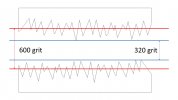i used 320 grit to remove most metal then 600 to smooth. i wanted to remove .002 but with polishing ended up at .0025. but worked ok might have needed the extra .0005. not real sure 1000 grit is going to do much
What many do not realize is that when you measure a surface, you are measuring the hight points on that surface. Think of the surface as corduroy. So, there is more material that has been removed that is below that surface. The coarser the grit, the wider the distance between high spots and the deeper the grooves. So when you go to a finer grit to polish, all you are doing is taking the tops off the ridges. So, you will tend to cut the measurable material faster because there is less to cut. Hence, finding you went too far. When in actuality, you probably went too far with the coarse grit, but could not measure it.
Here is an exaggerated diagram of what is going on. The Blue lines represents the diameter you measure after opening up the bore with 320 grit. The red lines represent the diameter you measure after polishing with 600 or finer grit. The red lines can move depending on how long you polish the bore. It will open up quickly at first and then slow down as you start to polish the entire surface and not just the high points left over from the coarser grit.
And keep in mind that the red lines are really not what you'll get. Since the ridges are unequal, the finer grit will remove pretty much the same amount from each ridge. So the diameter will vary within the bore. The more you polish, the more it will vary. Your sandpaper and stick are not a fixed hard surface. It will give as it encounters more resistance (wider areas. So the peaks will not be polished off equally. A metal lap is a better choice for the final polish as it will assure the bore remains cylindrical for it's length. It cannot vary (flex if it were sand paper) beyond the size of the lapping compound grit.
And when I made the peaks and valleys in that bore, I should have drawn them so that the ID of the bore was bigger in the center with each end a bit smaller. When you go back and forth with your sanding stick, unless you fully exit each end or dwell at each end, you end up polishing the center twice for every pass of the ends.


